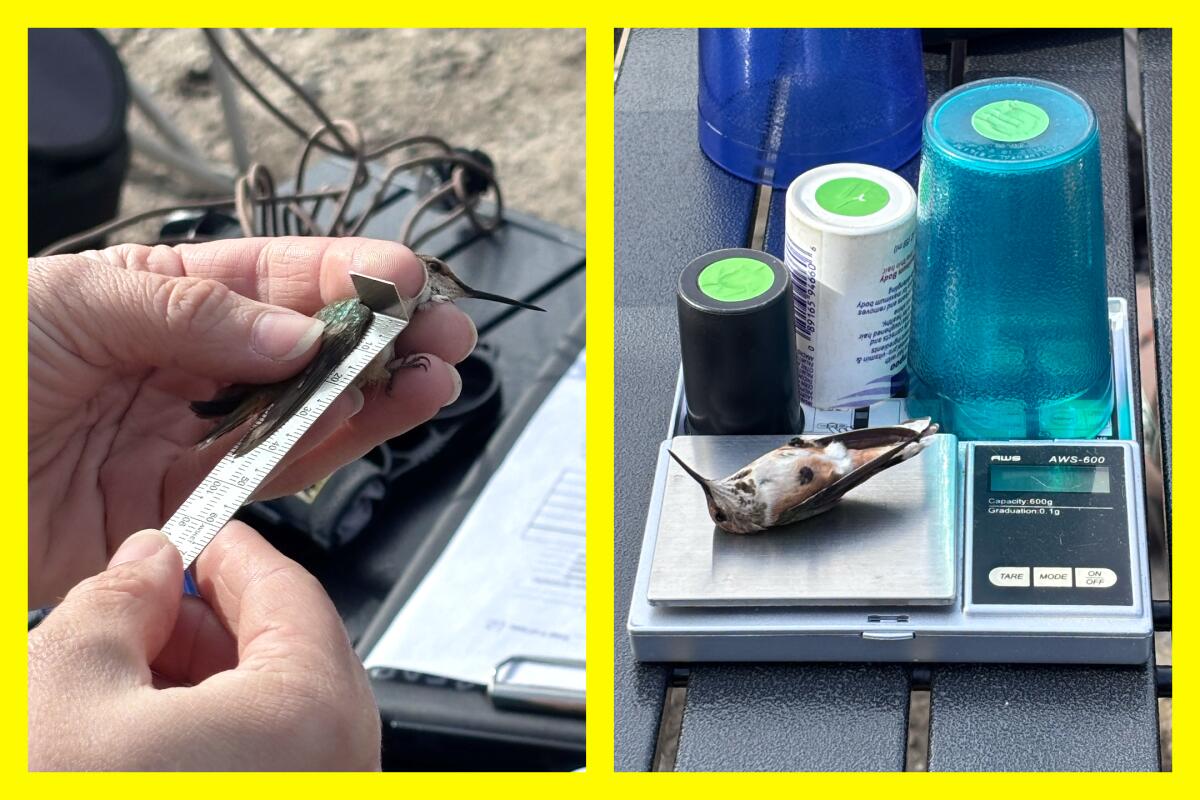I did not expect the hummingbird to be so calm as a biologist gently placed the bird’s wing on a caliper to measure it.
The tiny flying jewel laid stock-still on the pocket scale. Her wing was 44 millimeters, or about 1.7 inches, and she weighed 3.3 grams, between the weight of a penny and a nickel. Soon, biologist Lauren Hill held the bird in her hand and softly blew on her to signal it was time for her to return to her migration.
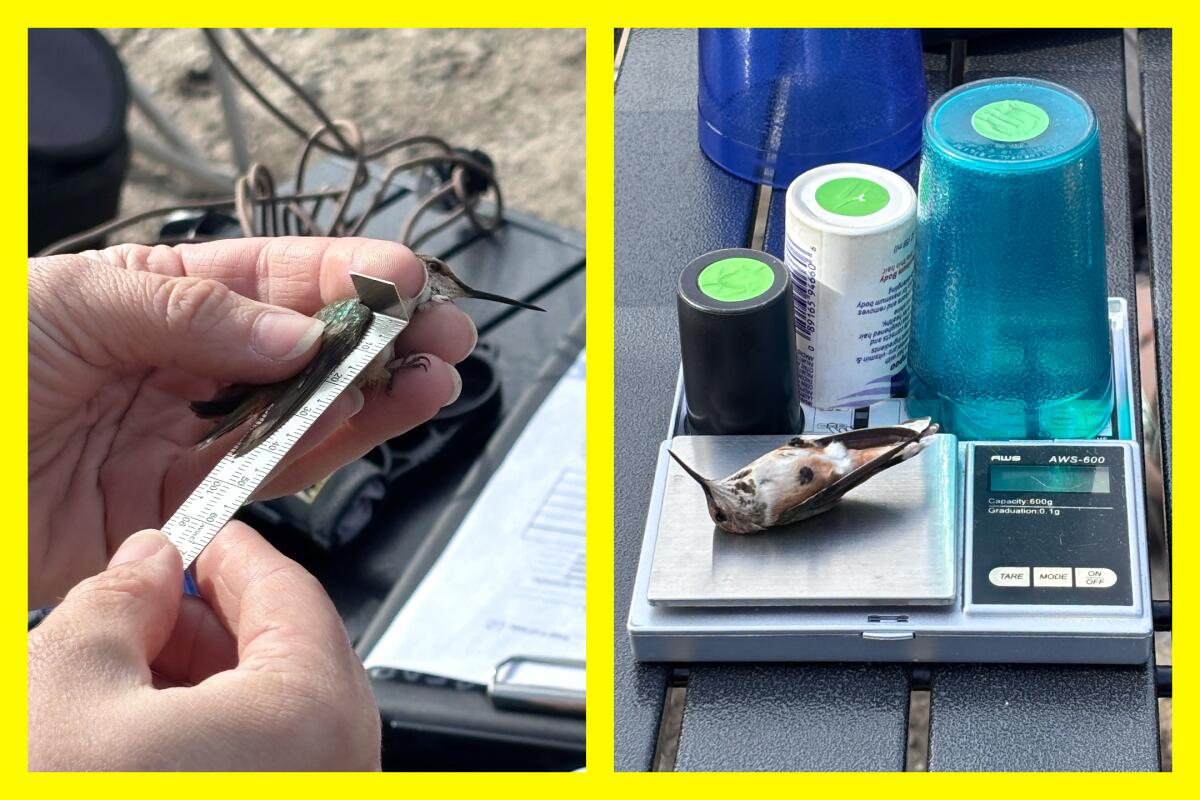
(L) Biologist Lauren Hill measures the wing of a hummingbird at the Bear Divide banding station. (R) A female hummingbird weighs in at 3.3 grams at the Bear Divide banding station.
(Jaclyn Cosgrove / Los Angeles Times)
This is a common scene at the Bear Divide Banding Station, where Hill co-leads a team of volunteers to catch and document migratory birds. Volunteers place tiny metal bands with nine digits, like an avian Social Security number, on most of the birds’ legs before releasing them. The data they collect contributes to multiple scientific studies and provides a greater understanding of the migratory patterns of the more than 100 species who fly through the narrow pass in Angeles National Forest.
One of the best parts is: You’re invited to come watch.
Newsletter
You are reading The Wild newsletter
Sign up to get expert tips on the best of Southern California’s beaches, trails, parks, deserts, forests and mountains in your inbox every Thursday
You may occasionally receive promotional content from the Los Angeles Times.
That’s what makes their work special, Hill said. Bird-banding projects are often on private land and inaccessible to the public.
“We have this whole public outreach component to our research,” Hill said. “Obviously research is paramount and No. 1, but we have this really cool opportunity to also share this and bridge this gap between community and the sciences, which is not a very common thing, especially for banding research.”
Today’s Wild focuses on opportunities for you to safely observe — and even contribute to research — of native wildlife. Though your average Angeleno likely has a laundry list of cool animals they’ve spotted on the trail or by the ocean, it can be rare even for the most active of hikers to see wildlife up close. Luckily, L.A. has several events where you can do that, which is how I ended up within arm’s reach of a hummingbird.
At the banding station, researchers regularly interact with 10 warbler species, 17 species of sparrows, nine species of flycatchers and six species of hummingbirds.
To collect the birds, volunteers set up (and take down) 10 soft polyester nets, each 40 feet long and 8 feet wide, across the hillside.
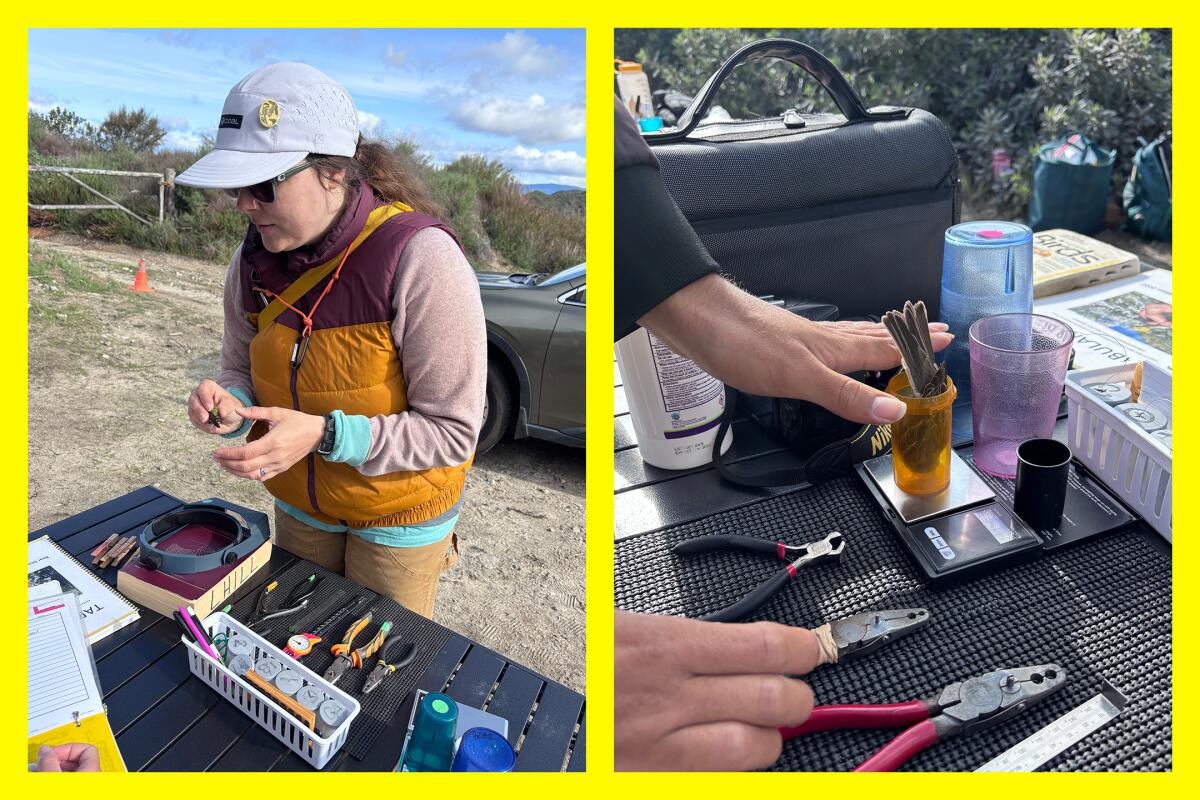
(L) Lauren Hill, a biologist and co-lead bird bander at Bear Divide banding station, tells a recorder the measurements of the hummingbird in her hand. (R) A bird being weighed at the Bear Divide banding station near Santa Clarita in Angeles National Forest.
(Jaclyn Cosgrove / Los Angeles Times)
As birds fly from the southeast through the narrow canyon, some of them will hit a net and drop into a pocket of the net. If conditions are “optimal,” Hill said, meaning low wind and moderate temperatures, they will check the nets every 30 minutes. If the weather is wet and foggy, volunteers will check either every 15 minutes or continuously.
During their peak season, between late April and early May, they will check the nets nonstop. A typical banding station can catch 30 birds a day, but Bear Divide will see a far larger number in peak season. One day, they caught 183 birds, and that was with volunteers taking down nets and ending early to ensure they could tend to the birds they’d caught.
“Everything we do here is to minimize any bird stress,” Hill said. “You might hear people having negative comments about the methods of bird banding, but what we do here is extremely safe, and very rarely do we have instances of injured or stressed birds. We operate a pretty tight ship.”
After a volunteer takes a bird from a net, they will place them in a breathable cotton bag and hang the bag on a line near the station where they’ll take the birds out in order, prioritizing hummingbirds, kinglets, towhees and other birds prone to stress.
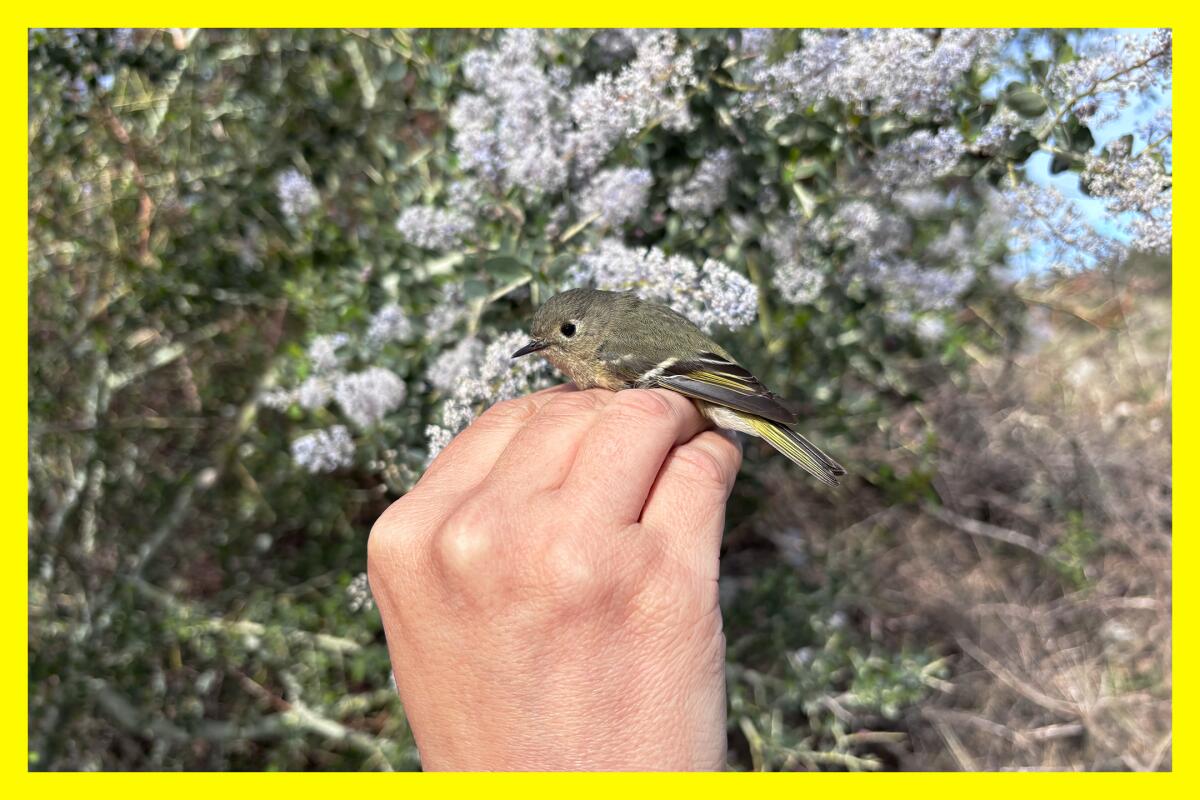
A ruby-crowned kinglet after it was measured and banded at the Bear Divide banding station near Santa Clarita.
(Jaclyn Cosgrove / Los Angeles Times)
Once the bird is out of the bag, a volunteer places an aluminum band on its leg with a unique number, and a volunteer will measure the bird’s wing length, mass and other crown or wing patch color if necessary. They also blow the bird’s feathers apart to check fat deposits (which I said sounds a bit personal!), breeding condition and pectoral muscles.
“A skilled bander will take anywhere from 30 to 60 seconds to process a bird,” Hill said. “The whole thing is very quick.”
In previous years, volunteers allowed members of the public to release the birds but aren’t this year out of an abundance of caution regarding bird flu. (Per federal data, the species handled by the Bear Divide volunteers are at low risk of carrying the disease.)
Since starting in 2021, 40 volunteers have documented 82 species of birds, banding 7,125. (They don’t band hummingbirds because that requires a different protocol and permit, but they do measure them.)
It remains unclear why Bear Divide is such a hotspot for migratory birds. The site was discovered by accident when a scientist was standing in a nearby parking lot and noticed hundreds of birds flying overhead.
Regardless, it is special not only because of its accessibility to the public but also because of the diversity of birds one can see there during the day. Birds typically migrate at night, but “morning flight” is a phenomenon well documented in eastern North America, in places like Cape May, the Tadoussac Dunes in Quebec and portions of Lake Erie.
Hill told me that there’s a large gap in the scientific understanding of Western migratory patterns. Butterbredt Spring in eastern Kern County is the only other place in California where morning flight is known to occur.
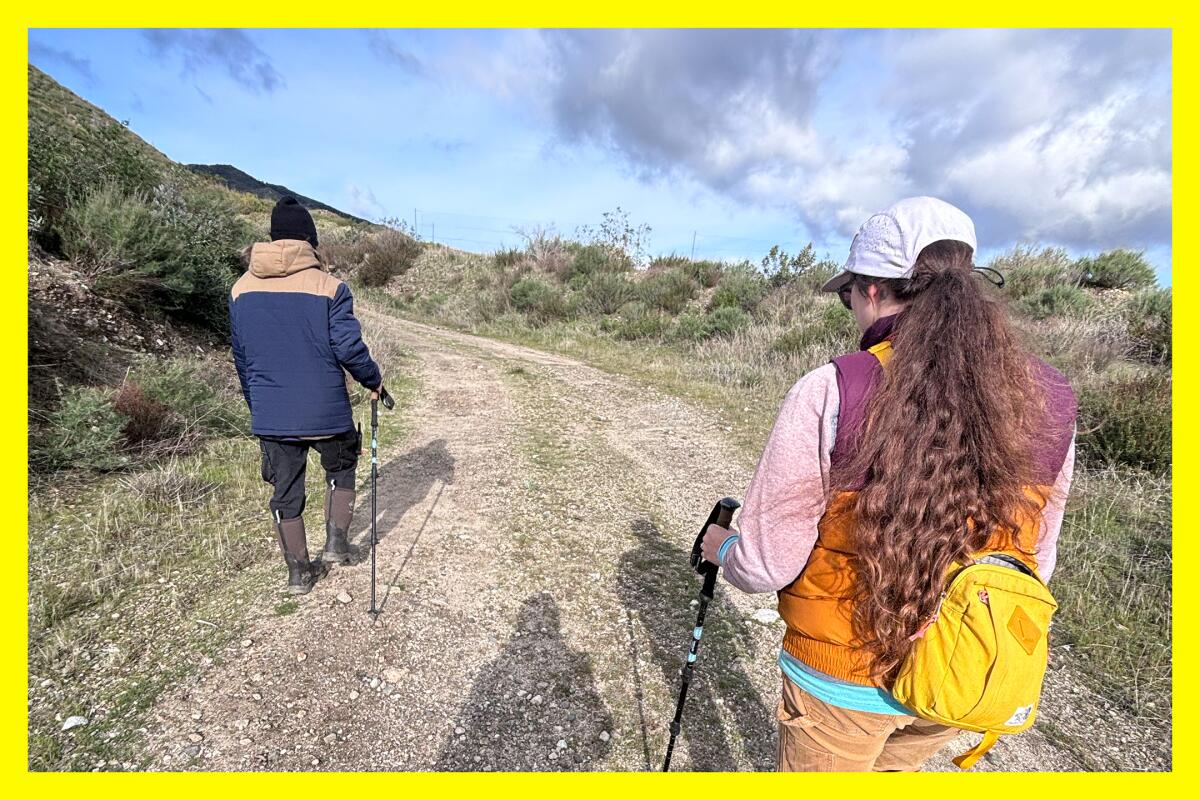
Lauren Hill, a biologist and co-lead bird bander at Bear Divide banding station, heads up the trail to check one of the nets for birds. Generally, any birds caught in the nets will be measured, and some will be banded.
(Jaclyn Cosgrove / Los Angeles Times)
At Bear Divide, morning flight can be witnessed for eight weeks out of the year for three hours, starting an hour after sunrise. It peaks in late April to early May.
Volunteer Alexander deBarros, who hosts bird walks for the San Fernando Valley Audubon Society, told me that at Bear Divide, he gets to see hermit warblers, MacGillivray’s Warbler, Nashville warblers, dusky flycatchers, Allen’s hummingbirds and more.
“Those are all birds we get here pretty regularly that I hardly ever see anywhere else,” he said.
Guess what, dear reader? The banding station is just one of several wildlife-themed activities that you can participate in around L.A. Below you’ll find opportunities to see a variety of our feathered and flippered neighbors!
1. Bear Divide Banding Station
Season: Mid-March to early June
Location: Near Santa Clarita in Angeles National Forest
Where to learn more: beardividebanding.com

A sea turtle pokes his head above water in the San Gabriel River near the 405 Freeway overpass in Seal Beach.
(Mark Boster / Los Angeles Times)
2. Monitor green sea turtles in the San Gabriel River 🐢
Season: Year-round
Location: Long Beach
Where to learn more: aquariumofpacific.org
Almost 20 years ago, two volunteers with the Aquarium of the Pacific found that Pacific green sea turtles live in the San Gabriel River year-round. That launched an effort between local and federal agencies to study and protect the northernmost known location of endangered green sea turtles. And also: an exciting volunteer opportunity.
On the first Saturday of every month, trained volunteers travel along the San Gabriel River to monitor, count and document the turtles’ activities. The job of a turtle-seeking volunteer is significant. Volunteers have contributed to more than 10 years of research, including the publication of a research paper and developing a turtle photo ID program. Recently, volunteers spotted two turtles entangled in fishing line. One was freed on site, and the other was taken to an animal hospital for surgery and is now recovering.
Even though the waters where they swim are known for trash and other pollution, the turtles, experts say, are doing well.
“The green sea turtles in the San Gabriel River are thriving,” Dan Lawson, a biologist with the National Marine Fisheries Service, told The Times in 2017. “Over the past decade, we’ve seen about 100 of them in the river and in nearby Alamitos Bay, Anaheim Bay, Huntington Harbor and the Naval Weapons Station.
“But they’d be a lot happier if our regulatory agencies did a better job of controlling trash in the river,” he said.
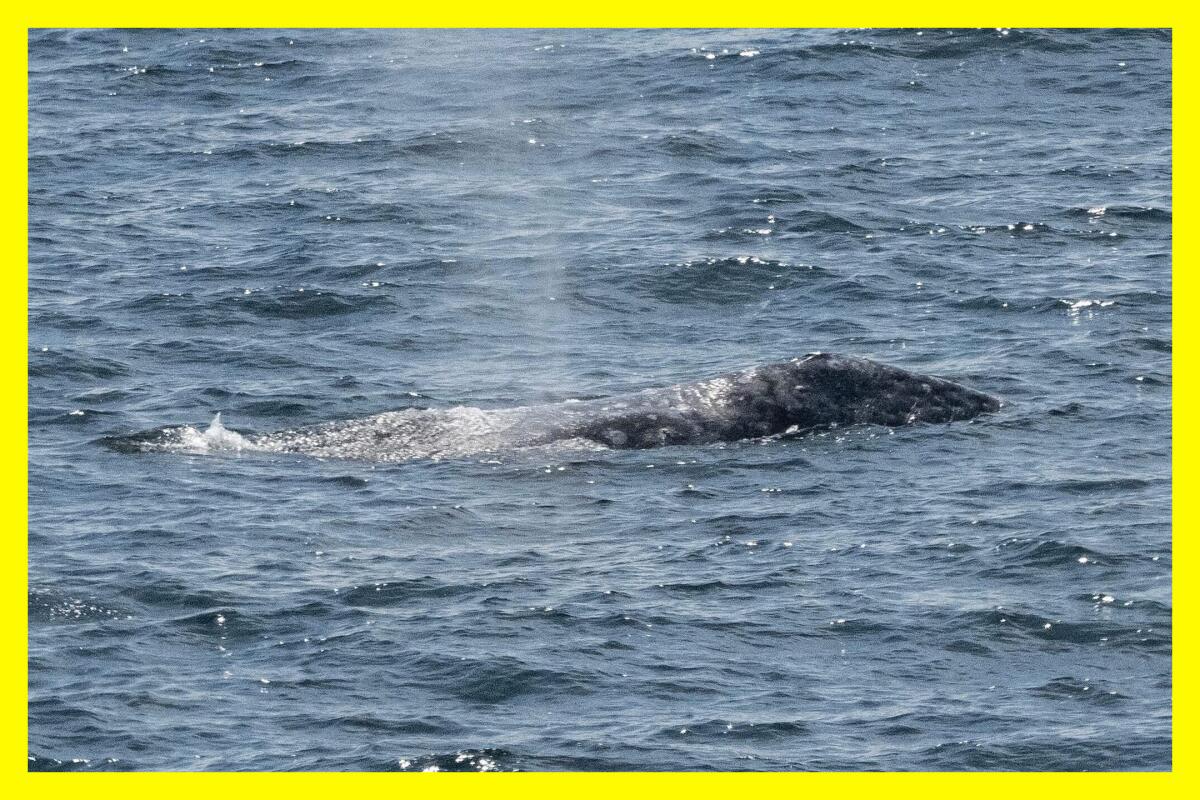
A gray whale spotted near Point Vicente in Rancho Palos Verdes.
(Nina Whiddon)
3. Spot gray whales in Rancho Palos Verdes 🐳
From now until late May, you can head to the patio of the Point Vicente Interpretive Center in Rancho Palos Verdes, where you’ll find a dedicated group of volunteers using high-powered binoculars to count gray whales for the American Cetacean Society’s annual count of migrating eastern North Pacific gray whales. Members of the public are welcome to hang out on the patio with their binoculars, as more eyes help spot more whales. The project has operated every year since 1979, outside of a few off years, and its primary station is the center’s patio.
The volunteers will count the whales from sunrise to sunset daily until late May. This month, you’re most likely to spot cows and their calves migrating north from the lagoons in Mexico, where the mamas give birth and care for their young. Pregnant and nursing whales and their newborn calves are the last to leave the lagoons, heading out in March to mid-April.
To learn more about how to spot gray whales and other marine life from the coastline, read this Wild. No registration is required to observe the count. Learn more about the count at the society’s L.A. chapter website.
Other honorable mentions of animal research around L.A. include:
- City Nature Challenge 2025, this Friday through Monday, hosted by the Natural History Museum
- Los Angeles Raptor Study, applications accepted year-round, organized by Friends of Griffith Park
- Native Bumble Bee Workshop, from 10 a.m. to 1 p.m. May 3, organized by Friends of Griffith Park
- Project Phoenix, monitoring how birds respond to wildfire smoke, July 1 to Nov. 30
- The annual grunion run 🐟💘 Small silvery fish who rush onto beaches to lay their eggs, including at Cabrillo Beach near the Los Angeles Harbor entrance; several dates now through August

3 things to do

(Patrick Hruby / Los Angeles Times)
1. Join us for a hiking chat at the Festival of Books
Have you ever wanted to meet two of the people who make The Wild possible? Here’s your chance! Times Wellness editor Alyssa Bereznak and I invite you to attend our panel at The Times’ Festival of Books, titled “Ask a Reporter: Explore the Great Outdoors,” at 10:30 a.m. Saturday at Mudd Hall 203 on the USC campus. We’ll talk about the best places to explore in and around L.A., and I will share what I’ve learned from writing Between a Rock, our monthly outdoors survival series. Afterward, please visit the Times Plants booth, where you can learn about growing native plants and get free seeds and swag. Tickets are required for our talk, but entry is generally allowed if the (temperature-controlled!) room isn’t full.
2. Hike the Rim of the Valley in L.A.
The National Parks Conservation Assn. and snack company Nature Valley will host an outdoors-themed gathering from 9 a.m. to noon Saturday at the Audubon Center at Debs Park (4700 Griffin Ave.). Participants can take a guided nature walk, among other interactive activities offered in English and Spanish. The walk will venture through the Rim of the Valley, a 118,000-acre region of the Santa Monica Mountains that activists want to see formally protected. To protect the sensitive habitat, organizers ask that you leave your dogs at home. Register at support.npca.org.
3. Celebrate Earth Day at San Gabriel River Park
Los Angeles County Parks & Recreation will host an Earth Day celebration from 3 to 6 p.m. Sunday at San Gabriel River Park (255 S. San Fidel Ave., La Puente). Volunteers can participate in a bioblitz, using their cellphones to photograph native flora and fauna and then post those images to community science app iNaturalist. Participants can also pick up trash, make buttons and learn about composting, among several other activities. Learn more at the park’s Instagram page.

The must-read

A Grizzly bear drinks from Pelican Creek as her two cubs stay close by her side.
(Jonathan Newton / Getty Images)
The mountains in Southern California, especially remote areas of Los Padres National Forest, could feasibly support 115 grizzly bears, should the state reintroduce the species made extinct by development and hunting. Times staff writer Lila Seidman reports on a new study that shows California could host about 1,180 grizzly bears in total, should policymakers and voters choose to reintroduce the apex predators. An official at the state’s Department of Fish and Wildlife said the move would increase human-bear conflicts — including with ranchers, already irked by the growing wolf population — and the large bruins could end up wandering beyond the remote regions where biologists released them. Still, experts say it is worth considering. The move could serve as a form of reparative justice between the state and Indigenous people. Octavio Escobedo III, chairman of the Tejon Indian Tribe, wrote in the foreword of the grizzly study about the “‘parallel paths’ forcibly walked by Native Americans and grizzlies subject to state-sanctioned ideology that ‘drove the relentless persecution of both Indigenous people and grizzly bears,’” Seidman wrote.
Happy adventuring,

P.S.
Mt. Wilson Observatory and the Cosmic Cafe are open for their 2025 season! You can now take Angeles Crest Highway from L.A. to the Mt. Wilson turnoff at the Red Box Picnic Area to reach the observatory. Check out the docent-led tours on Saturdays and Sundays, and make sure to grab a snack or meal at the Cosmic Cafe, as your purchases there help support the observatory. Although the Mt. Wilson hike from Sierra Madre remains closed, there are several hiking options in the area, including the Rim Trail, the accessible hike around Mt. Wilson and nearby Strawberry Peak. I’ll see you up there!
For more insider tips on Southern California’s beaches, trails and parks, check out past editions of The Wild. And to view this newsletter in your browser, click here.
